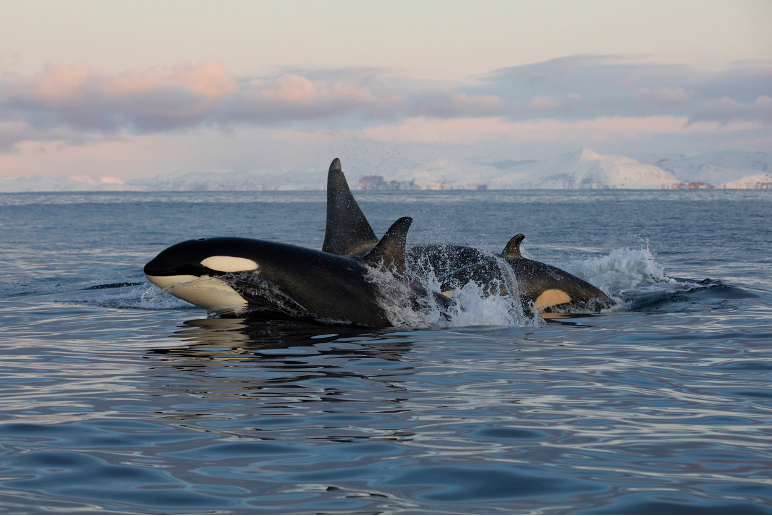About the project
The project MULTIWHALE will study the complex question of how multiple stressors (anthropogenic pollutants, disturbance from whale watching activities, and nutritional status) affect biological responses such as gene expression, endocrine, physiological, and behaviour at the individual and population levels in Norwegian killer whales.
We consider this in the context of intra-population variations in feeding ecology; some individuals are fish-specialists while others eat marine mammals in addition to fish. The latter are exposed to higher levels of pollutants, and thus may be more susceptible to the effects of anthropogenic stressors. We combine field studies, laboratory measurements and modelling tools to understand the short-term individual and long-term population level effects of multiple stressors, and how the effects are distributed within this ecologically structured population.
Risk assessments for marine mammals are often made in relation to a single stressor (e.g. pollution). However, the effects of individual stressors can be potentiated when occurring together. For example, lipid soluble contaminants are stored in the blubber, but can be remobilised in times of nutritional stress and start circulating in the blood and target organs. Similarly, acute stress from e.g. vessel disturbance can alter the ability to conserve metabolic stores by inducing gene networks that promote lipolysis and adipogenesis in mammalian adipocytes. Both nutritional stress and high levels of contaminants can negatively impact individuals' survival and reproduction, with further consequences on abundance and population growth.
MULTIWHALE will lead to important results that will improve our understanding of how a long-lived, social and wide-ranging top predator may respond to cumulative effects of multiple stressors. Presently facing a rapidly changing world, and with ecosystems being increasingly impacted by human stressors, the MULTIWHALE results will contribute to the growing and much needed field of multiple stressor ecology. Results will also have important implications for international contaminant regulations and implementation of sustainable tourism (whale watching). Lastly, our findings will be relevant to the assessment of population status of killer whales in Norway.
Partners
National partners:
- University of Oslo (UiO): Anders Ruus (PI), Katrine Borgå (co-PI), Postdoc Eve Jourdain, PhD Clare Andvik
- Norwegian University of Life Sciences (NMBU): Jan Ludvig Lyche
- Norwegian University of Science and Technology (NTNU): Andrew Foote
- Institute of Marine Research (IMR): Nils Øien
International partners:
- Stockholm University, Sweden: Bo Yuan
- McGill University, Canada: Melissa McKinney
- University of St Andrews, UK: Philip Hammond
- Fisheries and Ocean Canada: Tanya Brown
Collaborators:
- Norwegian Orca Survey (NOS): Richard Karoliussen
- Ocean Wise Conservation Association (OW): Marie Noël & Peter Ross
- Vongraven Natur og Media (VNM): Dag Vongraven
Master projects
The MULTIWHALE project started in June 2021. We will have some master projects available, in both 2021 and 2022. These will be advertised on the IBV website when they are ready, or contact Anders Ruus (PI), Katrine Borgå (co-PI), Postdoc Eve Jourdain, or PhD Clare Andvik.
Financing
This project is funded by The Research Council of Norway.
Period
Start: 01.06.2021 End: 31.05.2025
